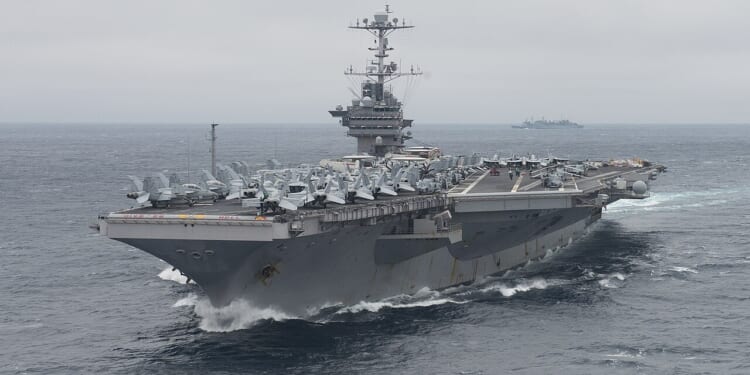The Navy will repair damage to the Truman from its recent collision in the Red Sea during its upcoming “Refueling Complex Overhaul” major mid-life maintenance period.
Earlier this month, the United States Navy was involved in a massive and very literal cover-up involving its eighth Nimitz-class nuclear-powered supercarrier. USS Harry S. Truman (CVN-75) was pier side as President Donald Trump gave a speech in Norfolk, Virginia, to commemorate the 250th anniversary of the founding of the Continental Navy, which occurred on October 13, 1775. While speaking to the military personnel, Trump stood next to a massive banner featuring the word “NAVY” over a large golden anchor on a blue background.
Although it is well-known that gold is the president’s favorite color—to the point that his affection for the shiny metal has been compared to that of a certain James Bond supervillain—the gold wasn’t present to appeal to Trump’s aesthetic tastes. Instead, the large banner was intended to conceal damage that the flattop suffered in February when it collided with a 53,000-ton Panamanian-flagged cargo ship while operating in the Mediterranean Sea near Port Said, Egypt.
The USS Harry S. Truman’s Fender Bender at Sea
The impact with the merchant vessel Besiktas-M damaged a sponson on the starboard side near one of the aircraft elevators, and it tore through the exterior bulkheads of two storage rooms as well as a maintenance space.
The carrier’s nuclear reactors, as well as its watertight integrity, were not affected. Nor were the aircraft elevators damaged in any significant way. However, CVN-75 was forced to return to Souda Bay, Greece, for an Emergent Repair Availability (ERAV). The installation of new bulkheads and some paint was completed, and the warship returned to service less than two weeks later.
Eight months after the collision, the repairs remain incomplete, but likely for a good reason: the USS Harry S. Truman was already set to undergo a planned maintenance that will be much larger in scale, and which will take at least three to four years to complete.
“The exterior cosmetic damage to USS Harry S. Truman (CVN 75) sustained from the collision will get repaired during the ship’s upcoming Refueling Complex Overhaul (RCOH) at Newport News Shipbuilding as planned,” a US Navy official told The War Zone. “Immediately following the collision, while in Souda Bay, Greece, new bulkheads were installed inside each of the damaged spaces to establish weathertight integrity.”
Even as the damage was cosmetic, it was too significant for an “Intermediate” or “Depot” maintenance period. Instead, the decision was made to wait until the aircraft carrier begins its midlife refueling, which is now expected to begin next year. Once completed, that refueling will extend the service life of the carrier for another 25 years.
The Truman’s Cursed Mediterranean Cruise
Besides the damage taken during the collision, CVN-75 also returned from her extended deployment with three fewer fighters from her air wing than she arrived in the Mediterranean with.
One of the carrier’s F/A-18 Super Hornets was notoriously shot down in a friendly fire incident in December 2024, mistakenly identified as a hostile missile and fired upon by the Ticonderoga-class guided-missile cruiser USS Gettysburg (CG-64), one of the warships in the Truman carrier strike group (CSG). Fortunately, both pilots were able to eject safely and were quickly rescued.
Then, in April and May, two other Super Hornets were lost while the carrier was operating in the Red Sea. The first of those two aircraft fell off the supercarrier while being towed to the hangar, reportedly as the USS Harry S. Truman endeavored to avoid a Houthi attack. Another F/A-18 crashed into the Red Sea just weeks later after a malfunction of its arrestment system, which is needed to slow the fighter as it lands on the flight deck. The pilot also ejected and was rescued.
About the Author: Peter Suciu
Peter Suciu has contributed over 3,200 published pieces to more than four dozen magazines and websites over a 30-year career in journalism. He regularly writes about military hardware, firearms history, cybersecurity, politics, and international affairs. Peter is also a contributing writer for Forbes and Clearance Jobs. He is based in Michigan. You can follow him on Twitter: @PeterSuciu. You can email the author: [email protected].
Image: Wikimedia Commons.


















